formerly eScholarship Editions


|
|
|
|
Your search for
'Art History' in subject
found 61 book(s). | Modify Search | Displaying 1 - 20 of 61 book(s) | |
| 1. | 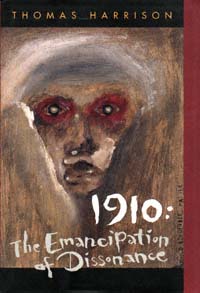 | Title: 1910, the emancipation of dissonance Author: Harrison, Thomas J 1955- Published: University of California Press, 1996 Subjects: Literature | Comparative Literature | European Literature | Art History Publisher's Description: The year 1910 marks an astonishing, and largely unrecognized, juncture in Western history. In this perceptive interdisciplinary analysis, Thomas Harrison addresses the extraordinary intellectual achievement of the time. Focusing on the cultural climate of Middle Europe and paying particular attention to the life and work of Carlo Michelstaedter, he deftly portrays the reciprocal implications of different discourses - philosophy, literature, sociology, music, and painting. His beautifully balanced and deeply informed study provides a new, wider, and more ambitious definition of expressionism and shows the significance of this movement in shaping the artistic and intellectual mood of the age. 1910 probes the recurrent themes and obsessions in the work of intellectuals as diverse as Egon Schiele, Georg Trakl, Vasily Kandinsky, Georg Lukàcs, Georg Simmel, Dino Campana, and Arnold Schoenberg. Together with Michelstaedter, who committed suicide in 1910 at the age of 23, these thinkers shared the essential concerns of expressionism: a sense of irresolvable conflict in human existence, the philosophical status of death, and a quest for the nature of human subjectivity. Expressionism, Harrison argues provocatively, was a last, desperate attempt by the intelligentsia to defend some of the most venerable assumptions of European culture. This ideological desperation, he claims, was more than a spiritual prelude to World War I: it was an unheeded, prophetic critique. [brief] Similar Items |
| 2. | 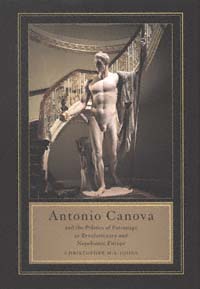 | Title: Antonia Canova and the politics of patronage in revolutionary and Napoleonic Europe Author: Johns, Christopher M. S Published: University of California Press, 1998 Subjects: Art | Art History | European Studies | European History Publisher's Description: The Venetian sculptor Antonio Canova (1757-1822) was Europe's most celebrated artist from the end of the ancien régime to the early years of the Restoration, an era when the traditional relationship between patrons and artists changed drastically. Christopher M. S. Johns's refreshingly original study explores a neglected facet of Canova's career: the effects of patrons, patronage, and politics on his choice of subjects and manner of working. While other artists produced art in the service of the state, Canova resisted the blandishments of the political powers that commissioned his works.Johns uses letters, diaries, and biographies to establish a political personality for Canova as an individual and an artist of international reputation. Though he had patrons as diverse as the pope, Napoleon, the Austrian Hapsburgs, the Prince Regent of Great Britain, and the Republic of Venice, Canova remained steadily employed and did so without controversy. A conservative and a Catholic, he devised a strategy that enabled him to work for patrons who were avowed enemies while remaining true to the cultural and artistic heritage of his Italian homeland. Using myth and funerary images and avoiding portraiture, he disguised the meanings behind his works and thus avoided their being identified with any political purpose.Johns greatly enhances our understanding of Canova's place in European art and political history, and in showing the influence of censorship, display, visual narrative, and propaganda, he highlights issues as contentious today as they were in Canova's time. [brief] Similar Items |
| 3. | 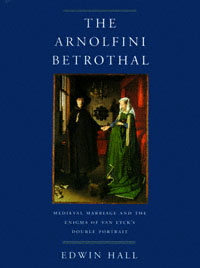 | Title: The Arnolfini betrothal: medieval marriage and the enigma of Van Eyck's double portrait Author: Hall, Edwin 1928- Published: University of California Press, 1997 Subjects: Art | Art History | Art Criticism | Medieval History Publisher's Description: Commonly known as the "Arnolfini Wedding" or "Giovanni Arnolfini and His Bride," Jan van Eyck's double portrait, painted in 1434, is probably the most widely recognized panel painting of the fifteenth century. One of the great masterpieces of early Flemish art, this enigmatic picture has also aroused intense speculation as to its precise meaning. Edwin Hall's accessible study - firmly grounded in Roman and canon law, theology, literature, and the social history of the period - offers a compelling new interpretation of this wonderful painting.Instead of depicting the sacrament of marriage, Hall argues, the painting commemorates the alliance between two wealthy and important Italian mercantile families, a ceremonious betrothal that reflects the social conventions of the time. Hall not only unlocks the mystery that has surrounded this work of art, he also makes a unique contribution to the fascinating history of betrothal and marriage custom, ritual, and ceremony, tracing their evolution from the late Roman Empire through the fifteenth century and providing persuasive visual evidence for their development. His illuminating view of Van Eyck's quintessential work is a striking example of how art continues to endure and engage us over the centuries. [brief] Similar Items |
| 4. | 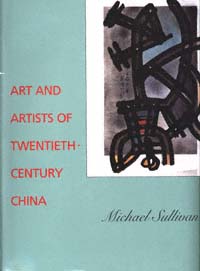 | Title: Art and artists of twentieth-century China Author: Sullivan, Michael 1916- Published: University of California Press, 1996 Subjects: Art | Art History | China Publisher's Description: This visually stunning book focuses on the rebirth of Chinese art in the twentieth century under the influence of Western art and culture. Michael Sullivan, recognized throughout the world as a leading scholar of Chinese art, vividly documents the conflicting pulls of traditional and Western values on Chinese art and provides 364 illustrations, in color and black-and-white, to show the great range of artistic expression and the historical processes that occurred within various movements. A substantial biographical index of twentieth-century Chinese artists is a valuable addition to the text.Sullivan discusses artists and their work against China's background of oppression and relaxation, despair and hope. He expertly conveys the diverse and at times bizarre intertwining of Chinese cultural history and art during this century. Included are the intense debates between traditionalists and reformers, the creation of the first art schools, and the birth of the idea - shocking in ethnocentric China - that art is a world language that obliterates all frontiers. The scholarly traditions of classical Chinese painting, the belated discovery of Western modernism, the artistic upheaval under Communism, and China's rethinking of the very nature of art all have a place in Sullivan's fascinating history.Michael Sullivan has known many of the major figures in China's modern art movement of the 1930s and 1940s and has also gained the confidence of younger artists who rose to prominence following the 1979 "Peking Spring." This long-awaited book - richly documented and abundantly illustrated - is a capstone to Sullivan's work and will be enthusiastically welcomed by art lovers everywhere. [brief] Similar Items |
| 5. | 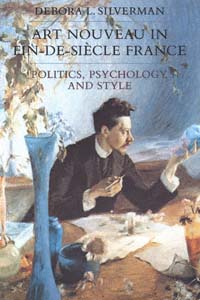 | Title: Art nouveau in fin-de-siècle France: politics, psychology, and style Author: Silverman, Debora Leah Published: University of California Press, 1989 Subjects: History | Art History | French Studies | European History | Intellectual History Similar Items |
| 6. | 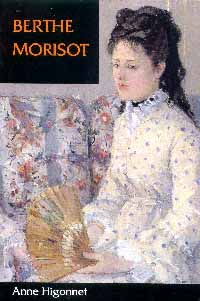 | Title: Berthe Morisot Author: Higonnet, Anne 1959- Published: University of California Press, 1995 Subjects: Art | Art History | Autobiographies and Biographies | Women's Studies Publisher's Description: Of the six Impressionist painters whose first exhibition scandalized and fascinated Paris in 1874, Berthe Morisot was the only woman. She reached a pinnacle of artistic achievement despite the restraints society placed on her sex, adroitly combining her artistic ambitions with a rewarding family lif . . . [more] Similar Items |
| 7. | 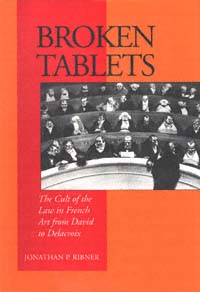 | Title: Broken tablets: the cult of the law in French art from David to Delacroix Author: Ribner, Jonathan P Published: University of California Press, 1993 Subjects: Art | Art History | French Studies | European Literature | European History | Law Publisher's Description: In this first study of art, law, and the legislator, Jonathan Ribner provides a revealing look at French art from 1789 to 1848, the period in which constitutional law was established in France. Drawing on several disciplines, he discusses how each of the early constitutional regimes in France used imagery suggesting the divine origin and sacred character of its laws.Primarily a study of art and politics, Broken Tablets discusses painting, sculpture, prints, and medals (many reproduced here for the first time), as well as contemporary literature, including the poetry of Alfred de Vigny, Alphonse de Lamartine, and Victor Hugo. Ribner assesses the ways in which legislation imagery became an instrument of political propaganda, and he clearly illuminates the cult of the law as it became personalized under Napoleon, monarchist under the Restoration, and defensive under Louis-Phillipe. [brief] Similar Items |
| 8. | 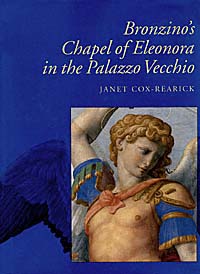 | Title: Bronzino's Chapel of Eleonora in the Palazzo Vecchio Author: Cox-Rearick, Janet Published: University of California Press, 1993 Subjects: Art | Art History Publisher's Description: Do the sacred decorations of a Florentine Renaissance chapel - saints, symbols, and scriptural stories - hold personal and political meanings? Cox-Rearick's ground-breaking book explores the message hidden in the frescoes and altar panels of the Chapel of Eleonora di Toledo, painted in the early 1540s by Agnolo Bronzino for the Spanish-born wife of Duke Cosimo I de Medici. Bronzino, then the chief painter to the Medici court, was largely responsible for the invention in Florence of the highly self-conscious, elegant Maniera style. Cox-Rearick interweaves her account of the Medici biography with an examination of Bronzino's commission in the broader context of his oeuvre.Cox-Rearick reveals the Chapel of Eleonora as an intimately devised decorative program that transmits messages about its patrons and Medici rule. Detailed color photographs of the newly restored art splendidly document this early tour de force of a major artist whose works are still relatively unexamined. [brief] Similar Items |
| 9. | 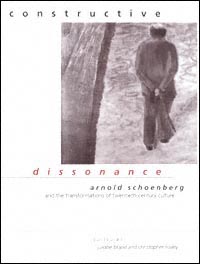 | Title: Constructive dissonance: Arnold Schoenberg and the transformations of twentieth-century culture Author: Brand, Juliane Published: University of California Press, 1997 Subjects: Music | Musicology | Composers | Intellectual History | Art History Publisher's Description: Arnold Schoenberg (1874-1951) is a pivotal figure of musical modernism. The "father of serialism" has influenced nearly every major composer of this century, and the idea of Schoenberg, now wild-eyed radical, now embattled moralist, now lonely prophet, is woven into the mythos of modern art. What is more, the sites of his professional activity - fin de siècle Vienna, the Berlin of the Weimar Republic, and his "exile to paradise" in Los Angeles - bring home the representative quality of his life and works, which bear witness to some of the defining experiences of our time.This collection by leading Schoenberg scholars is an interdisciplinary examination of the historical, aesthetic, and intellectual issues that formed Schoenberg's creative persona and continue to influence our response to the modernist legacy of the first half of this century. The book's first section, "Contexts," investigates Schoenberg's sense of ethnic, religious, and cultural identity. The second section, "Creations," focuses on specific works and the interplay between creative impulse and aesthetic articulation. The final section, "Connections," addresses the relationship of Schoenberg's legacy to present-day thought and practice. [brief] Similar Items |
| 10. | 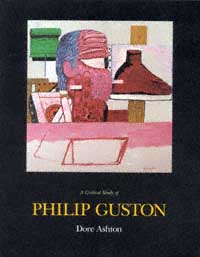 | Title: A critical study of Philip Guston Author: Ashton, Dore Published: University of California Press, 1990 Subjects: Art | Art History | Art Criticism | Autobiographies and Biographies Publisher's Description: Dore Ashton has updated the bibliography and added a new concluding chapter to her classic study of the paintings and drawings of Philip Guston, the only study of his work completely authorized by the artist.Philip Guston (1913-1980) was one of the most independent of the painters whose work was loosely linked by the term "abstract expressionism" during the 1950s, and he baffled admirers of his lushly beautiful abstract expressionist paintings by moving abruptly in mid-career to gritty figurative paintings in an almost cartoon-like style. One of the few critics who saw this at the time as a progressive development in his work was Dore Ashton, who here analyzes Guston's paintings and drawings in the context of the cultural milieu in which he worked, illuminating the dilemma facing artists who try to live with, understand, and express both the ideals of art and the reality of the world. [brief] Similar Items |
| 11. | 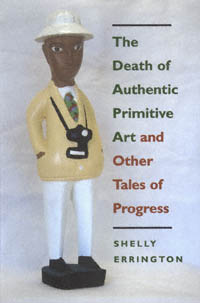 | Title: The death of authentic primitive art and other tales of progress Author: Errington, Shelly 1944- Published: University of California Press, 1998 Subjects: Anthropology | Cultural Anthropology | Art History | Architectural History | Art Theory Publisher's Description: In this lucid, witty, and forceful book, Shelly Errington argues that Primitive Art was invented as a new type of art object at the beginning of the twentieth century but that now, at the century's end, it has died a double but contradictory death. Authenticity and primitivism, both attacked by cultural critics, have died as concepts. At the same time, the penetration of nation-states, the tourist industry, and transnational corporations into regions that formerly produced these artifacts has severely reduced supplies of "primitive art," bringing about a second "death."Errington argues that the construction of the primitive in the nineteenth and twentieth centuries (and the kinds of objects chosen to exemplify it) must be understood as a product of discourses of progress - from the nineteenth-century European narrative of technological progress, to the twentieth-century narrative of modernism, to the late- twentieth-century narrative of the triumph of the free market. In Part One she charts a provocative argument ranging through the worlds of museums, art theorists, mail-order catalogs, boutiques, tourism, and world events, tracing a loosely historical account of the transformations of meanings of primitive art in this century. In Part Two she explores an eclectic collection of public sites in Mexico and Indonesia - a national museum of anthropology, a cultural theme park, an airport, and a ninth-century Buddhist monument (newly refurbished) - to show how the idea of the primitive can be used in the interests of promoting nationalism and economic development.Errington's dissection of discourses about progress and primitivism in the contemporary world is both a lively introduction to anthropological studies of art institutions and a dramatic new contribution to the growing field of cultural studies. [brief] Similar Items |
| 12. | 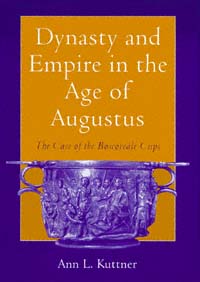 | Title: Dynasty and empire in the age of Augustus: the case of the of the Boscoreale Cups Author: Kuttner, Ann L Published: University of California Press, 1995 Subjects: Art | Art History | Classical History | Ancient History Publisher's Description: The two silver skyphoi commonly known as the Boscoreale Cups of Augustus and Tiberius are indispensable for providing the documentation of one of the only two cycles of Roman imperial state reliefs to survive from the Julio-Claudian period. Ann Kuttner offers the first comprehensive examination of these historical treasures.Kuttner studies the Cups not only from the standpoint of art history but also as they relate to Augustan ideology and politics. When she began work on this book, the whereabouts of the Cups was unknown, and she had to rely on the illustrations in Monuments et Memoires (Fondation Eugen Pinot, 1901). The rediscovery of the Cups at the Louvre in late 1990 has allowed Kuttner to examine them directly. [brief] Similar Items |
| 13. | 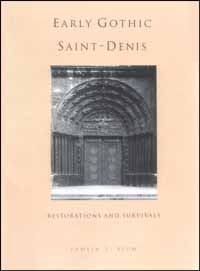 | Title: Early Gothic Saint-Denis: restorations and survivals Author: Blum, Pamela Z Published: University of California Press, 1992 Subjects: Art | Architectural History | Art History | Medieval Studies | Archaeology Publisher's Description: quality. Indeed, the well-preserved sculptural passages provide a key to the Early Gothic style as well as revealing the distinct imprints of three artists and their influences on each other. Blum's penetrating analyses of the restorative techniques and materials are accompanied by telling photograph-diagrams that distinguish the original work from that done later.Pamela Blum's investigation has relevance not only for students and scholars of medieval art but for curators and collectors as well. Anyone concerned with survivals from the past will appreciate her scrupulous detection in studying one of France's greatest monuments. [brief] Similar Items |
| 14. | 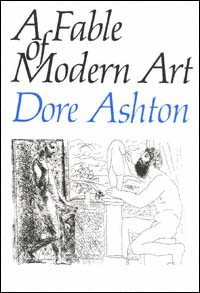 | Title: A fable of modern art Author: Ashton, Dore Published: University of California Press, 1991 Subjects: Art | Art History | Art Theory | Intellectual History Publisher's Description: Dore Ashton's masterly analysis of modern art grows out of a consideration of Balzac's brilliant and little known 'philosophic' story The Unknown Masterpiece in which the concerns of Cézanne, Picasso, and the abstract expressionists are strikingly prefigured. Balzac's fable is discussed not only within the context from which it emerged - early nineteenth-century romanticism - but also in its embodiment of various attitudes towards art. Ashton illuminates a web of associations linking Balzac to Cézanne, Rilke, Schoenberg, Kandinsky and Picasso as they struggle with the yearning to express the inexpressible, to make concrete the abstract.As Professor Ashton develops the conjectures of her book she reveals the interrelations of literature, music, and art and the basic problems which engage or beset the contemporary artist and those who seek to understand and appreciate contemporary art. This is a book of extreme originality which ranges so widely and offers such valuable insights that it forms an important contribution not only to the history of art and culture, but also to the history of ideas. [brief] Similar Items |
| 15. | 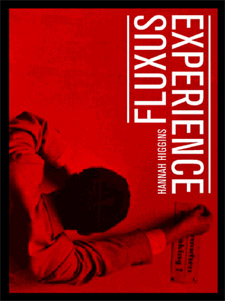 | Title: Fluxus experience Author: Higgins, Hannah 1964- Published: University of California Press, 2002 Subjects: Art | Art History | Art Theory | Art Criticism Publisher's Description: In this groundbreaking work of incisive scholarship and analysis, Hannah Higgins explores the influential art movement Fluxus. Daring, disparate, contentious - Fluxus artists worked with minimal and prosaic materials now familiar in post-World War II art. Higgins describes the experience of Fluxus for viewers, even experiences resembling sensory assaults, as affirming transactions between self and world. Fluxus began in the 1950s with artists from around the world who favored no single style or medium but displayed an inclination to experiment. Two formats are unique to Fluxus: a type of performance art called the Event, and the Fluxkit multiple, a collection of everyday objects or inexpensive printed cards collected in a box that viewers explore privately. Higgins examines these two setups to bring to life the Fluxus experience, how it works, and how and why it's important. She does so by moving out from the art itself in what she describes as a series of concentric circles: to the artists who create Fluxus, to the creative movements related to Fluxus (and critics' and curators' perceptions and reception of them), to the lessons of Fluxus art for pedagogy in general. Although it was commonly associated with political and cultural activism in the 1960s, Fluxus struggled against being pigeonholed in these too-prescriptive and narrow terms. Higgins, the daughter of the Fluxus artists Alison Knowles and Dick Higgins, makes the most of her personal connection to the movement by sharing her firsthand experience, bringing an astounding immediacy to her writing and a palpable commitment to shedding light on what Fluxus is and why it matters. [brief] Similar Items |
| 16. | 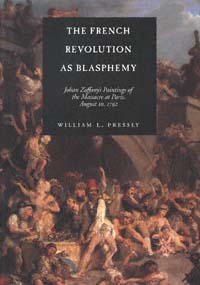 | Title: The French Revolution as blasphemy: Johan Zoffany's paintings of the massacre at Paris, August 10, 1792 Author: Pressly, William L 1944- Published: University of California Press, 1999 Subjects: Art | Art History | European History | French Studies Publisher's Description: William Pressly presents for the first time a close analysis of two important, neglected paintings, arguing that they are among the most extraordinary works of art devoted to the French Revolution. Johan Zoffany's Plundering the King's Cellar at Paris, August 10, 1792 , and Celebrating over the Bodies of the Swiss Soldiers , both painted in about 1794, represent events that helped turn the English against the Revolution.Pressly places both paintings in their historical context - a time of heightened anti-French hysteria - and relates them to pictorial conventions: contemporary history painting, the depiction of urban mobs in satiric and festival imagery, and Hogarth's humorous presentation of modern moral subjects, all of which Zoffany adopted and reinvented for his own purposes. Pressly relates the paintings to Zoffany's status as a German-born Catholic living in Protestant England and to Zoffany's vision of revolutionary justice and the role played by the sansculottes, women, and blacks. He also examines the religious dimension in Zoffany's paintings, showing how they broke new ground by conveying Christian themes in a radically new format.Art historians will find Pressly's book of immense value, as will cultural historians interested in religion, gender, and race. [brief] Similar Items |
| 17. | 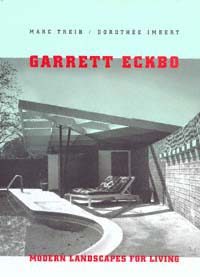 | Title: Garrett Eckbo: modern landscapes for living Author: Treib, Marc Published: University of California Press, 1997 Subjects: Architecture | Art History | California and the West Publisher's Description: One of the central figures in modern landscape architecture, Garrett Eckbo (1910-2000) was a major influence in the field during an active career spanning five decades. While most of the early American designers concentrated on the private garden and the corporate landscape, Eckbo's work demonstrated innovative design ideas in a social setting. This engagement with social improvement has stayed with Eckbo throughout his life, distinguishing both his intentions and achievements, from his early work for the Farm Security Administration to his partnerships (including one of the most prominent landscape firms in the world, Eckbo, Dean, Austin, and Williams - EDAW) and his years as chair of the Department of Landscape Architecture at the University of California, Berkeley.In an elegant and detailed book that includes more than 100 of Eckbo's designs, Marc Treib examines the aesthetic formation of Eckbo's manner, and by implication the broader field of landscape architecture since the 1930s. Dorothée Imbert writes about Eckbo's social vision, including his belief that ultimately, landscape design is the "arrangement of environments for people ." The book also contains a biographical and professional chronology and a complete bibliography of publications by and about Garrett Eckbo. [brief] Similar Items |
| 18. | 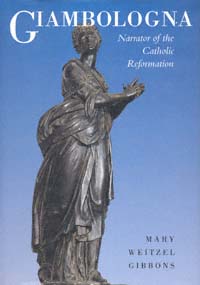 | Title: Giambologna: narrator of the Catholic Reformation Author: Gibbons, Mary Weitzel 1929- Published: University of California Press, 1995 Subjects: Art | Art History Publisher's Description: Arguably the pre-eminent European sculptor of his age, but historically considered little more than the facile court sculptor to the grand dukes of Florence, Giambologna played a major role in the artistic transformations of the late sixteenth century. Mary Weitzel Gibbons seeks to broaden our hitherto limited view of Giambologna's work by considering his neglected Genoese masterpiece, the Grimaldi Chapel. Although the chapel itself was destroyed during the Napoleonic period, its dazzling bronzes of Virtues and angel-putti and a Passion cycle in relief have survived. The fine detail and rich color of the bronzes are featured in color plates and black-and-white images photographed especially for this book.Gibbons reassesses Giambologna's work, clearly defining his relation to the narrative tradition and his role as an artist of the Catholic Reformation. Her new insights into the artist's work will appeal to all those intrigued by this turbulent era in Western European history. [brief] Similar Items |
| 19. | 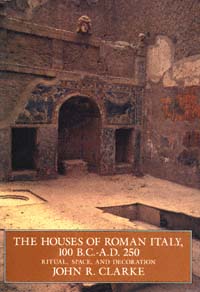 | Title: The houses of Roman Italy, 100 B.C.-A.D. 250: ritual, space, and decoration Author: Clarke, John R 1945- Published: University of California Press, 1992 Subjects: Classics | Art and Architecture | Architectural History | Art History Publisher's Description: In this richly illustrated book, art historian John R. Clarke helps us see the ancient Roman house "with Roman eyes." Clarke presents a range of houses, from tenements to villas, and shows us how enduring patterns of Roman wall decoration tellingly bear the cultural, religious, and social imprints of the people who lived with them.In case studies of seventeen excavated houses, Clarke guides us through four centuries of Roman wall painting, mosaic, and stucco decoration, from the period of the "Four Styles" (100 B.C. to A.D. 79) to the mid- third century. The First Style Samnite House shows its debt to public architecture in its clear integration of public and private spaces. The Villa of Oplontis asserts the extravagant social and cultural climate of the Second Style. Gemlike Third-Style rooms from the House of Lucretius Fronto reflect the refinement and elegance of Augustan tastes. The Vettii brothers' social climbing helps explain the overburdened Fourth-Style decoration of their famous house. And evidence of remodelling leads Clarke to conclude that the House of Jupiter and Ganymede became a gay hotel in the second century.In his emphasis on social and spiritual dimensions, Clarke offers a contribution to Roman art and architectural history that is both original and accessible to the general reader. The book's superb photographs not only support the author's findings but help to preserve an ancient legacy that is fast succumbing to modern deterioration resulting from pollution and vandalism. [brief] Similar Items |
| 20. | 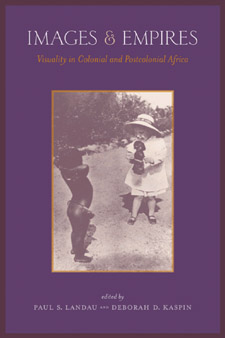 | Title: Images and empires: visuality in colonial and postcolonial Africa Author: Landau, Paul Stuart 1962- Published: University of California Press, 2002 Subjects: Anthropology | African Studies | Art History | Cultural Anthropology | History Publisher's Description: Figurative images have long played a critical, if largely unexamined, role in Africa - mediating relationships between the colonizer and the colonized, the state and the individual, and the global and the local. This pivotal volume considers the meaning and power of images in African history and culture. Paul S. Landau and Deborah Kaspin have assembled a wide-ranging collection of essays dealing with specific visual forms, including monuments, cinema, cartoons, domestic and professional photography, body art, world fairs, and museum exhibits. The contributors, experts in a number of disciplines, discuss various modes of visuality in Africa and of Africa, investigating the interplay of visual images with personal identity, class, gender, politics, and wealth. Integral to the argument of the book are over seventy contextualized illustrations. Africans saw foreigners in margarine wrappers, Tintin cartoons, circus posters, and Hollywood movies; westerners gleaned impressions of Africans from colonial exhibitions, Tarzan films, and naturalist magazines. The authors provide concrete examples of the construction of Africa's image in the modern world. They reveal how imperial iconographies sought to understand, deny, control, or transform authority, as well as the astonishing complexity and hybridity of visual communication within Africa itself. [brief] Similar Items |